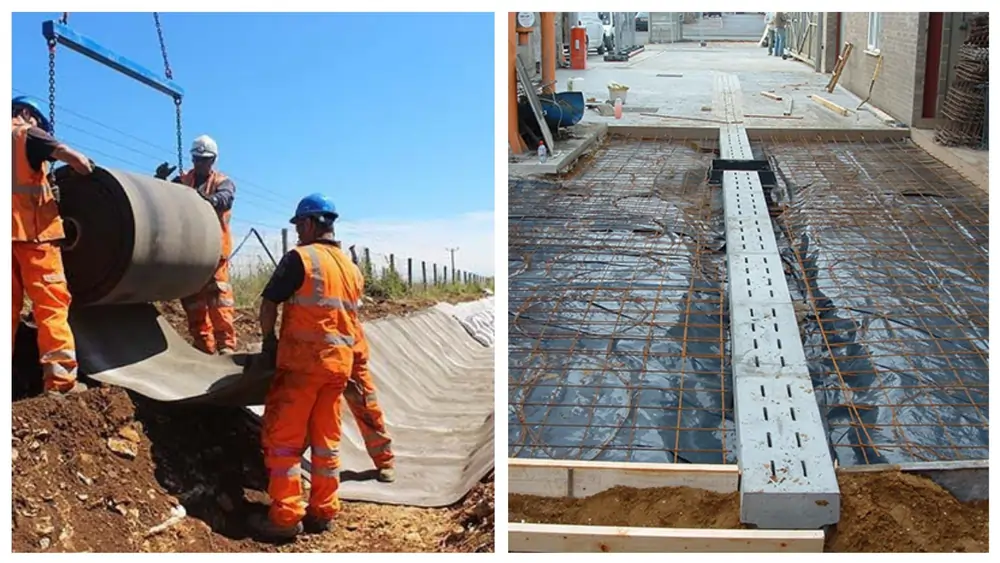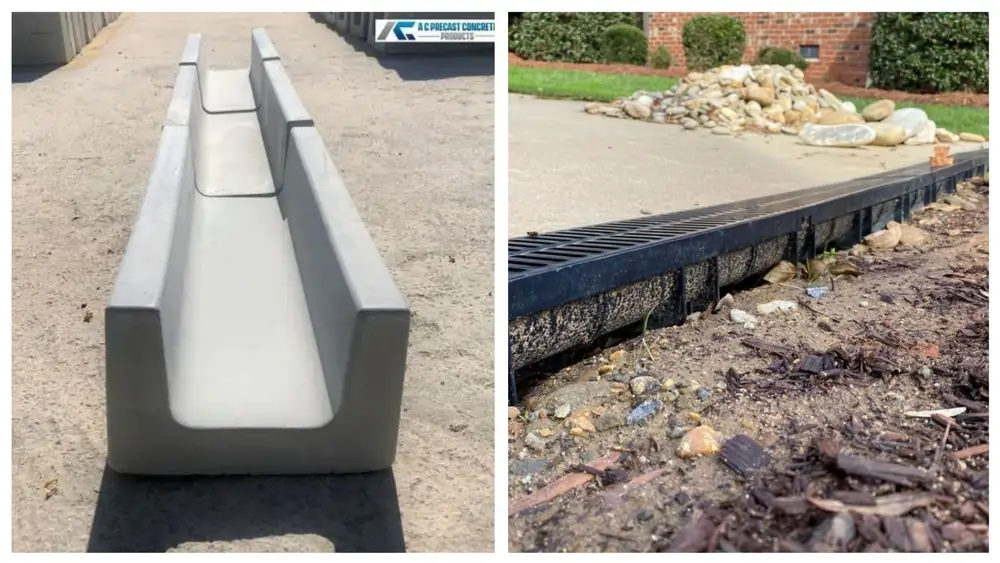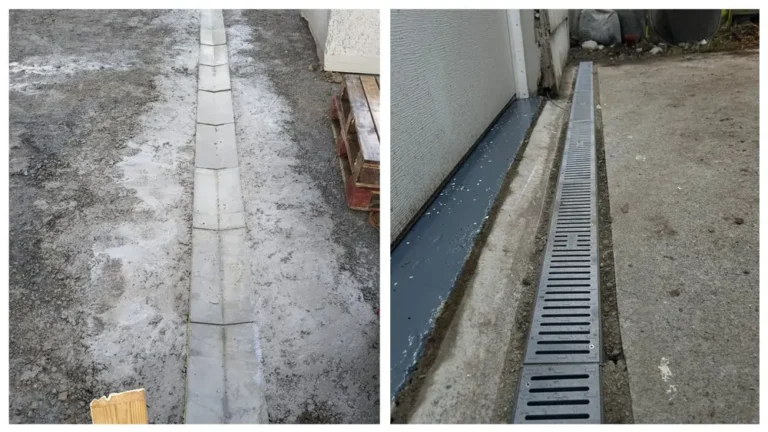Are you tired of water pooling in your driveway after every rainfall? Worried about flooding damaging your property? Concrete drainage channels might be the solution you’ve been searching for. These robust water drainage systems not only protect your property but also help manage stormwater effectively.
Concrete Drainage Channel
Managing water efficiently is critical, whether you’re dealing with stormwater or general runoff. Concrete drainage channels provide a robust and long-lasting solution. You might be surprised to learn that improper drainage causes billions in damage each year! So, understanding how these channels work and why they are essential could save you significant headaches down the road. In this guide, we’ll dive into everything you need to know about concrete drainage channels, from their installation to the top reasons they’re a top choice for homeowners and businesses alike. Let’s get into it!
What Are Concrete Drainage Channels?
Concrete drainage channels are engineered structures designed to collect and divert water away from specific areas. These channels, also known as trench drains, form a crucial part of any effective drainage system.
Definition and purpose of concrete drainage channels
A concrete drainage channel is a linear structure that collects and directs surface water or stormwater runoff. Its primary purpose is to prevent water accumulation, which can lead to flooding, erosion, and property damage.
Overview of materials used and construction methods
 Concrete drainage channels are typically made from:
Concrete drainage channels are typically made from:
- Portland cement
- Aggregates (sand and gravel)
- Water
- Reinforcing materials (steel bars or mesh)
Construction methods vary, but generally involve:
- Excavating a trench
- Creating a stable base
- Forming the channel
- Pouring concrete
- Finishing and curing
Comparison between concrete and other types of drainage systems
While plastic and metal drainage systems exist, concrete drainage channels offer unique advantages:
- Durability: Concrete withstands heavy loads and harsh environments better than plastic or metal.
- Longevity: Properly maintained concrete channels can last for decades.
- Customization: Concrete can be molded into various shapes and sizes on-site.
But how do these benefits translate to real-world applications? Let’s explore further.
Benefits of Using Concrete Drainage Channels
Using concrete drainage systems like channel drains is a game-changer for managing surface water. These concrete water channels are super effective and cost-effective, especially when you grab them from Home Depot. The precast drainage channel sections make installation a breeze. With a grate on top, they stop debris from clogging the drain system.
Whether you’re looking for polymer concrete or fiberglass, these concrete channel drains (also known as a trench drain) have got you covered. They’re heavy duty and can handle a lot of water without backup. Plus, they come in different styles like shallow or slot drains. Perfect for any project, whether it’s around a slab or an outlet.
Don’t forget to check out the ADA compliant options if accessibility is a concern. And since Reddit is anonymous, you can always get in touch with other users for tips on the best way to install these systems. Just remember, once you buy, you can’t change the product, so make sure to read the privacy policy and other details before adding it to your cart. For any updates, check your inbox!
Durability and longevity of concrete drainage solutions
Concrete drainage channels are built to last. They can withstand:
- Heavy vehicle traffic
- Extreme temperature fluctuations
- Chemical exposure
This durability translates to a longer lifespan, often exceeding 50 years with proper maintenance.
Low maintenance requirements
Unlike other materials, concrete requires minimal upkeep:
- Periodic cleaning to remove debris
- Occasional inspection for cracks or damage
This low-maintenance nature saves time and money in the long run.
Resistance to environmental factors
 Concrete’s robust nature makes it resistant to:
Concrete’s robust nature makes it resistant to:
- Erosion: Crucial for areas with high water flow
- UV radiation: No degradation from sunlight exposure
- Freeze-thaw cycles: Important in colder climates
Cost-effectiveness in long-term projects
While initial costs may be higher, concrete drainage channels prove more economical over time due to:
- Reduced replacement frequency
- Lower maintenance costs
- Increased property protection
Now that we understand the benefits, what types of concrete drainage channels are available?
Types of Concrete Drainage Channels
Hey, if you’re looking into types of concrete drainage channels, you gotta check out the pre-sloped sections. These bad boys are a cost-effective solution and super easy to install. They come in a whole channel system that requires less effort and time.
They are perfect for pool decks and areas with persistent standing water. Plus, the versatility is off the charts! Whether you need a pipe or a full-on frame setup, these channels act like a dream.
For pedestrian zones, they guarantee no obstruction. Just screw them in, and you’re good to go. If you need more info, just hit me up at my email address. Or you can find me on Google Maps with the email address associated with my business. Cheers!
Surface drainage channels
These channels are visible and collect water from the surface. They’re commonly used in:
- Parking lots: To prevent water pooling
- Driveways: To divert rainwater
- Industrial areas: To manage large volumes of runoff
Subsurface drainage channels
Hidden beneath the surface, these channels prevent water accumulation in soil and foundations. They’re crucial for:
- Protecting building foundations
- Preventing soil erosion
- Managing groundwater levels
Precast concrete drainage channels vs. custom-built solutions
Precast concrete channels offer:
- Faster installation
- Consistent quality
- Lower on-site labor costs
Custom-built solutions provide:
- Flexibility in design
- Ability to address unique site challenges
- Seamless integration with existing structures
Understanding the types is essential, but how are these channels installed?
Installation Process of Concrete Drainage Channels
So, the installation process of concrete drainage channels is pretty straightforward. First, you gotta prep the area and make sure it’s all leveled out.
Once that’s done, you can start laying the channels, making sure they’re aligned properly. They usually come in 4-6 ft sections for easy installation.
Don’t forget to secure them in place to avoid any movement. Trust me, it’s worth the effort to ensure a high-quality finish.
You’ll get a name for doing a top-notch job, and your clients will appreciate it. So, keep at it and you’ll be a pro in no time!
Planning and preparation
Proper planning involves:
- Site survey
- Determining drainage slope
- Identifying potential obstacles
Tools and materials required
Essential tools include:
- Excavator or shovel
- Laser level
- Concrete mixer
- Trowels and floats
Materials needed:
- Concrete mix
- Reinforcing steel
- Forms or precast sections
- Gravel for base layer
Step-by-step process of installing a concrete drainage channel
- Digging the trench: Excavate to the required depth and width
- Preparing the base: Add and compact a gravel layer
- Setting forms or placing precast sections: Ensure proper alignment and slope
- Pouring the concrete: For cast-in-place channels
- Finishing: Smooth the surface and create the desired profile
- Curing: Allow concrete to cure properly before use
Common mistakes to avoid during installation
- Inadequate slope leading to poor drainage
- Improper base preparation causing settling
- Neglecting expansion joints in longer channels
With installation complete, how do we keep these channels functioning optimally?
Maintenance Tips for Concrete Drainage Channels
Hey there! Just a quick heads-up on keeping your concrete drainage channels in top shape. First off, do a pre-check for any cracks or debris. Give it a good clean whilst you’re at it. Lastly, a bit of sealant can work wonders op those pesky leaks. Happy maintaining!
Regular inspection and cleaning
Inspect channels at least twice a year, more frequently in areas with heavy debris accumulation.
Dealing with blockages and debris
- Use high-pressure water jets for stubborn blockages
- Install debris guards to prevent large objects from entering
Repairing minor cracks and damage
Small cracks can be repaired with:
- Epoxy injections
- Cement-based patching compounds
For larger damage, consult a professional.
Now that we know how to maintain them, where are these channels commonly used?
Applications of Concrete Drainage Channels in Various Industries
Concrete drainage channels are super handy in various industries. In construction, they keep sites from flooding. In agriculture, they help with irrigation. And in roads, they prevent water buildup. These channels are pre-engineered to handle heavy loads and tough conditions, making them an essential part of infrastructure everywhere.
Residential applications
- Driveways: Prevent water pooling and ice formation
- Gardens: Manage excess water and prevent soil erosion
- Patios: Ensure proper drainage for outdoor living spaces
Commercial and industrial use
- Parking lots: Manage large volumes of runoff
- Warehouses: Protect inventory from water damage
- Factories: Handle industrial wastewater and runoff
Public works
- Roadways: Prevent flooding and improve safety
- Airports: Manage runway drainage
- Public parks: Control erosion and manage stormwater
With so many applications, what about the costs involved?
Cost Considerations for Concrete Drainage Channels
Initial cost vs. long-term savings
While upfront costs may be higher than other materials, concrete channels offer significant long-term savings through:
- Reduced maintenance
- Longer lifespan
- Better property protection
Cost breakdown
- Materials: 40-50% of total cost
- Labor: 30-40% of total cost
- Equipment: 10-20% of total cost
Factors affecting price
- Project size and complexity
- Site accessibility
- Local labor and material costs
Beyond cost, what about the environmental impact?
Environmental Impact and Sustainability of Concrete Drainage Channels
Preventing erosion and flooding
Properly designed concrete channels:
- Reduce soil erosion
- Prevent localized flooding
- Protect natural waterways
Recyclability of concrete
Concrete can be:
- Crushed and reused as aggregate
- Used as fill material
Eco-friendly drainage designs
- Permeable concrete options allow water infiltration
- Integration with rain gardens and bioswales
Conclusion
Concrete drainage channels play a crucial role in managing water efficiently, whether for residential, commercial, or public infrastructure. Their durability, low maintenance, and effectiveness make them an excellent long-term investment for anyone facing drainage challenges. Whether you’re considering installing them yourself or hiring professionals, the key is to plan carefully and ensure the right type of channel for your needs. Feel free to share your experiences or any questions in the comments below! Let’s make water management easier for everyone.
Concrete drainage channels offer a durable, cost-effective, and environmentally responsible solution for water management. From residential driveways to large-scale public works, these versatile systems play a crucial role in protecting property and managing stormwater. By understanding their benefits, installation process, and maintenance requirements, you can make an informed decision about implementing this effective drainage solution.

